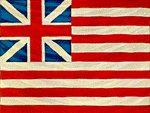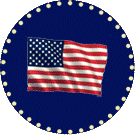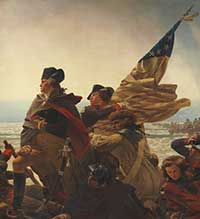Interpreting Old Glory.
The U.S. flag is one of the most recognized symbols on Earth — loved by many, reviled by some — everywhere it represents our country, its people, their heritage and aspirations. But why is it red, white and blue, and what do the stars and stripes represent?

Origins of the Flag. Flag-like emblems have been around as long as there have been organized societies — people need a way to identify which group a ship or army belongs to. But national as opposed to military flags only became common in the eighteenth century and the Stars and Stripes is one of the oldest flags in use today.
The first “American” flag appeared in 1775, months before independence was declared. It combined thirteen stripes with the British Union Jack, perhaps reflecting many colonists desire at the time to assert their rights as British citizens within the empire.
The first official U.S. flag was created by the Continental Congress on June 14, 1777. The resolution says:
“Resolved, That the flag of the thirteen United States be thirteen stripes, alternate red and white; that the union be thirteen stars, white in a blue field, representing a new constellation.”2

Surprisingly that’s it, nothing special — just one of many enactments passed that day, including one advancing several hundred dollars to independent military units and another suspending a naval commander alleged to be of dubious character.3
Why Is the Flag Red, White and Blue? Congress never said why it chose those colors — perhaps they simply were colors people were familiar with from the British Union Jack.
But several years later, when red, white and blue were chosen for the Great Seal, it was noted that they were the colors of the flag and conveyed the following meanings:
“White signifies purity and innocence; red denotes hardiness and valour, and blue signifies vigilance, perseverance and justice.”
Since then each generation has found is own meaning. President Reagan said “the colors of our flag signify the qualities of the human spirit we Americans cherish: red for courage and readiness to sacrifice; white for pure intentions and high ideals; and blue for vigilance and justice.”4
Why Stars and Stripes? Likewise Congress gave no reason for choosing stars and stripes. George Washington supposedly said:
“We take the stars from heaven, the red from our mother country, separating it by white stripes, thus showing that we have separated from her, and the white stripes shall go down to posterity representing liberty.”

Stars have long been used to symbolize aspiration and a desire to achieve greatness, and are important symbols to Freemasons. Many of the Founders were Masons and some historians believe that the stars in the flag were inspired by Masonry.5
Red and white stripes were one of the earliest Revolutionary symbols. They formed the Liberty Tree flag, which the Sons of Liberty adopted in 1767. Whoever designed the Stars and Stripes likely was familiar with the Liberty Tree flag and its importance in the evolution of American independence.

Fact or Fiction? It is hard to believe that the Founders paid so little attention to the flag’s creation, after all it’s the symbol of our country. But in Revolutionary times the flag was mostly a utilitarian object; it didn’t become a popular national symbol until the Civil War.
Thus much of the lore concerning the early history of the flag is just that. For example there are no contemporary accounts of Betsy Ross sewing the first flag; that story was first circulated by her grandson in the 1870s.8
And what about the flag in the famous painting of Washington crossing the Delaware? It wasn’t there. The crossing took place on Christmas Eve 1776, six months before the 1777 resolution creating the Stars and Stripes.
-----
- Image from The Sextant naval history web site.
- Journals of the Continental Congress, available on Library of Congress web site.
- Ibid.
- Presidential Proclamation 5475, declaring 1986 the Year of the Flag. Available at Reagan Library web site.
- Leepson, Marc. Flag: An American Biography. Thomas Dunne Books/St. Martin’s Press. 2005. p. 35.
- Image from Bostonian Society web site.
- Detail from Emanuel Leutze, Washington Crossing the Delaware, Metropolitan Museum of Art (1851). Image from museum’s web site.
- Leepson, Marc. Five myths about the American flag, The Washington Post (June 10, 2011).
This article originally appeared in our free semi-monthly newsletter. To receive future issues, please add your name to the subscription list.

